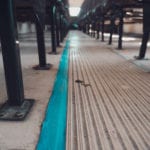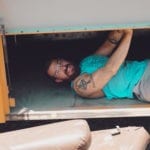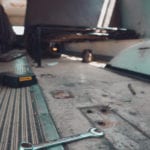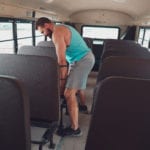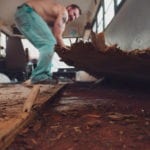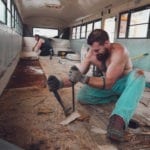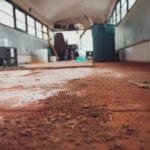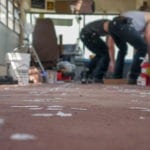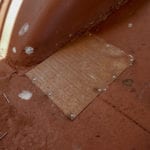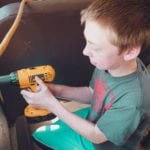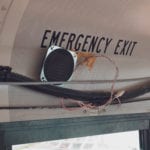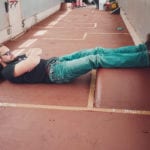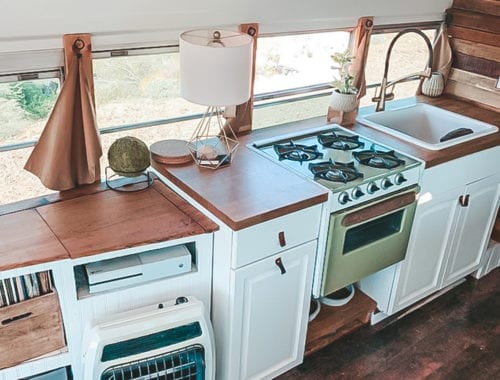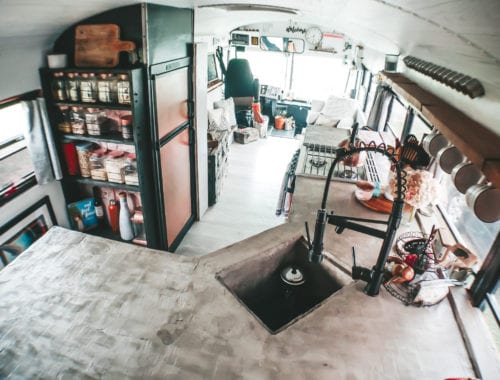Deconstructing a School Bus
Sometimes, in order to build something new, you have to tear down what’s already there. For example, deconstructing a school bus to turn it into a home.
In life, this is normally an agonizing process. Building better versions of ourselves, for example, generally involves some gut-wrenching moments as we’re forced to realize hard truths or endure painful situations.
However, when it comes to converting a bus into a home, it can also be really, really fun.
Make no mistake, bus deconstruction is tedious, time-consuming, physically draining and even painful at times. With the right attitude and mindset, however, it can also be incredibly satisfying and enjoyable.
At the very least, bus deconstruction taught us our first incredibly valuable lessons about what we could expect for the rest of the process.
First, your timetable carries absolutely no weight and is therefore irrelevant.
Finally, if you think you have everything you need, you’re wrong. You might as well keep the car running because you are going back to the store.
So – how does one tear apart a school bus?
In a nutshell – through a lot of brute force and swearing/bargaining with higher powers. In detail – well, keep reading.
STEP ONE – REMOVE THE SEATS
The first and most immediately satisfying step in deconstructing a school bus was removing all the seats. It went from a cramped school bus to a big, open space real fast. Having all the seats removed really showed us just how much space we had to work with.
The bench part of the seats was first.
On most school buses, they are attached by a couple of metal C-hooks. We assumed this would be pretty tough as we had previously watched a bus conversion documentary where the guy used a crowbar and thick work gloves to remove his seats. He seemed to be straining a lot.
So to test it, or maybe without thinking, Tawny walked up to the first seat, got in a good deadlift position, and pulled. Almost effortlessly the thing just popped off. So we went to town and boom, five minutes later we were done.
Riding high from this first success, we made for the wrenches to start unbolting the seat frames from the floor.
This did not prove to be the same smooth sailing experience as the cushions.
As it turned out, the seats were bolted not only to the floor but through the floor. The connecting nut to each bolt was under the bus. That meant that one person was on the bolt on the inside, and another person had to find the adjoining nut underneath.
Not as easy as it sounds. Each seat had anywhere from 8 to 12 bolts locking it down. Trying to communicate which one to work on was enough of a challenge by itself.
And that wasn’t our only problem.
DEALING WITH RUST
Rust is a funny thing. While it weakens the metal, like bolts, it can also cement them in place over time. The bolts that had been exposed to the elements (roughly 90% of them) had become rusted in place and impossible to remove with wrenches.
We tried using brute force, repeatedly spartan-kicking the seats that had a bolt or two removed trying to snap the rusty bolts off. It didn’t work well, although it did relieve some of the frustration that had started by day two when we were still only halfway done with this process.
Wedging ourselves between the seats and trying to leg press them out was a similar failure. To be fair, it worked once, but it nearly kicked the seat out of the windshield in the process.
I also about took my arm off on the window frame I was using as leverage and came about an inch away from “popsicling” myself on the upended leg of the seat as I rode the whole thing down the stairs and out the door.
Some blood was shed for the first time this day.
Eventually, we came to the conclusion that the only way was to use a grinder. Sadly, we’d actually known this ahead of time but had hoped to avoid it. Ultimately, we ended up wasting quite a lot of time with the whole spartan-kicking/leg-pressing attempts and used with the bloody grinder anyway.
Moral? Just use the angle grinder.
One by one, we ground off hundreds of bolts. HUNDREDS. If your children ride school buses to school, you can rest easy knowing things are absolute tanks and resist even the most purposeful attempts at demolition.
However – the finished job was well worth the trouble. We could see our space, we could begin envisioning our home.
STEP TWO – REMOVE THE FLOORING
The seats were removed, and we turned our attention to the floor.
Holy hell, I suddenly missed the seats.
I thought figuring out our floor plan would be the toughest part of the build. I was wrong.
The floor was comprised of several layers. The top layer was metal trim, lining the aisle and the wheel wells. Thanks to 14 years of muddy shoes, snowy boots, and spilled beverages, these too were cemented in with rusty screws.
We ended up using the claw end of a hammer and a crowbar to pry up most of the trim. There was a small amount that we were able to do with an actual screw gun, but it was few and far between. Looking back, I would have ordered this tool had I known how long it was going to take with a small crowbar.
The next layer was the superficial rubber linoleum. This was easy by comparison. It was simply glued down to the subfloor below it. Most of it came off in large junks, with small stubborn pieces here and there.
THE SUBFLOOR
The subfloor is by far the worst job of deconstructing a school bus.
It was comprised of 3/4 inch sheets of decades-old plywood. These were secured down with rusty nails and screws. We tried to use the screw gun at first, but it immediately stripped out the rusted screw heads.
Once again, we had to get creative, and the brute force/swearing resurfaced around this time.
The problem was, there were so many screws and nails securing it to the floor that trying to get an inch of leverage was nearly impossible.
It took hours of sweaty work in the hottest part of a Montana summer to finish this job. I think this may have been the first point we had second thoughts about this whole “let’s build a skoolie” business.
Once we finally got all of the subflooring out, we had to deal with the aftermath of our barbaric methods. Because we ripped the wood out, most of the screws and nails remained firmly planted in the metal base floor of the bus and had to be yanked out.
We were finally down to the metal base floor, which was, of course, rusted. We expected this, but there we some spots that were in pretty rough shape.
The metal near the wheel wells where water, snow, mud, and dirt were constantly kicked up took the worst of the damage. In some places, we could actually see through to the ground outside.
Luckily, Tawny’s dad is a metal worker and fixed us up with new metal patches riveted over the damage. After the repairs were made, we laid down a few coats of Rust-Oleum to protect the floor from further damage, and finally, almost a week later, the floor was done.
STEP THREE – REMOVE WALLS, LIGHTS, AND SPEAKERS
Along the walls of a bus are intermittent lights and speakers, covered by a plastic barrier that protects a spiderweb of wires connecting the whole business.
Some people choose to keep these in their conversion process, but our plan called for removal.
This was quick work compared to the floor and soon there was a pile of speakers and lights in the discard pile. After, we removed the split-loom tubing that covered all the wires in order to separate the necessary from the not-so-necessary.
On the latter list were the speaker and light wires, along with the buzzer system that prevented the bus from being started if certain windows were open – a problem since our back window didn’t fully latch.
Removing the metal walls and existing insulation is a personal preference. We chose to keep ours, mainly in order to avoid more mind-numbing work with the grinder. The extra few inches of space weren’t worth the trouble for us, and we’d decided to simply build over the top, gaining extra insulation under ours in the process.
DECONSTRUCTING A SCHOOL BUS
It was a long week, but looking back always makes us smile – because we were finally on the way, and even at times when swearing was the majority of our conversation, we were finally living the dream we’d been fostering for so long. We also had the benefit of working together with people we love who volunteered to help.
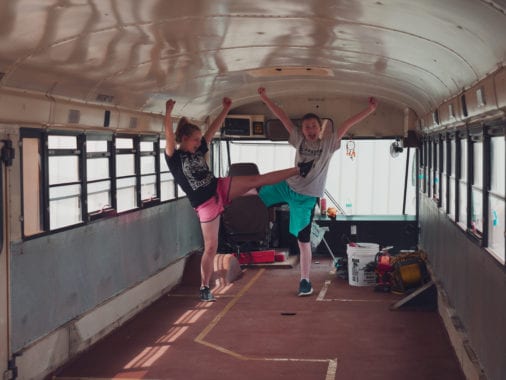
A bus conversion is like life – it’s a process.
Deconstructing a school bus is part of that process.
It’s not always the most enjoyable and can be frustrating at times, but if we can learn to live in the present and appreciate the moment, no matter what it looks like, the bigger picture slowly emerges and we can be grateful.
Even for that bloody grinder.

